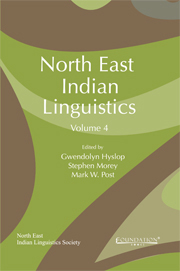Book contents
- Frontmatter
- Contents
- About the Contributors
- Foreword
- A Note from the Editors
- History, Contact and Evolution
- Bodo-Garo Grammar
- Orthography, Poetics and Text
- 7 Tshangla Orthography
- 8 Poetic Forms in Nocte, Singpho, Tai and Tangsa
- 9 A Multi-purpose Project for the Preservation of War Oral Literature
- New Descriptions
- Classifiers
- Eastern Indo-Aryan Grammar
- Austroasiatic
8 - Poetic Forms in Nocte, Singpho, Tai and Tangsa
from Orthography, Poetics and Text
Published online by Cambridge University Press: 05 May 2013
- Frontmatter
- Contents
- About the Contributors
- Foreword
- A Note from the Editors
- History, Contact and Evolution
- Bodo-Garo Grammar
- Orthography, Poetics and Text
- 7 Tshangla Orthography
- 8 Poetic Forms in Nocte, Singpho, Tai and Tangsa
- 9 A Multi-purpose Project for the Preservation of War Oral Literature
- New Descriptions
- Classifiers
- Eastern Indo-Aryan Grammar
- Austroasiatic
Summary
Introduction
In this paper we will examine poetic forms of four languages spoken in Upper Assam and Arunachal Pradesh, India: Nocte, Singpho, Tai and Tangsa. As far as we know there are no words that equate to English ‘poem’ or ‘poetry’ in any of these languages, though each of the languages has a word for ‘song’, and has words for different song styles, such as dance song or antiphonal (call and response) song. Except for the Ahom texts in §5 (which are taken from manuscripts), the examples in this paper were all performed with melody and sometimes rhythmic accompaniment such as the beat of the pestle on the mortar during rice-pounding (see below §3). All could thus also be termed ‘songs’ and it is not easy to make a distinction in these communities between ‘poem’ and ‘song’. Some styles resemble sprechstimme, a style of song more approaching spoken form, and some styles are more melodic (see List 1963: 9 for a discussion of such different styles). In this paper we will not deal with the musical melody. Poetic devices are also found in story telling, but we will not deal with those here.
Kiparsky (1973: 231) claimed that the “fundamental stylistics of poetry … have existed from the beginning”, based on comparison of poetics in ancient and modern times. We expect that the features of the poetry discussed in this paper represent very old and deep cultural artefacts, and will illuminate our knowledge of these languages.
- Type
- Chapter
- Information
- North East Indian Linguistics , pp. 145 - 165Publisher: Foundation BooksPrint publication year: 2012
- 1
- Cited by



